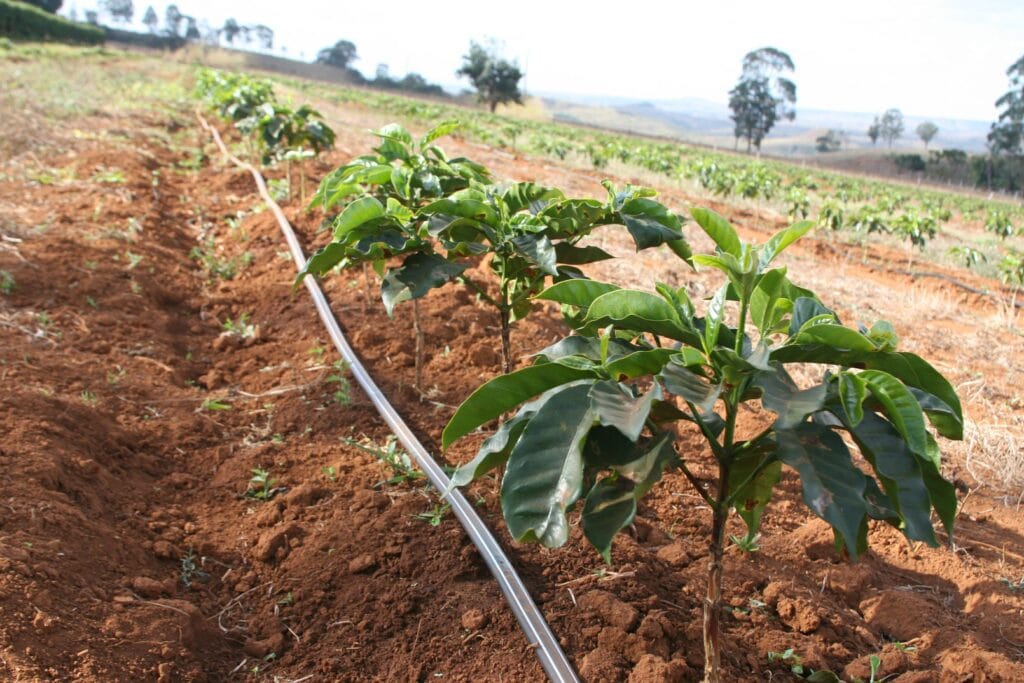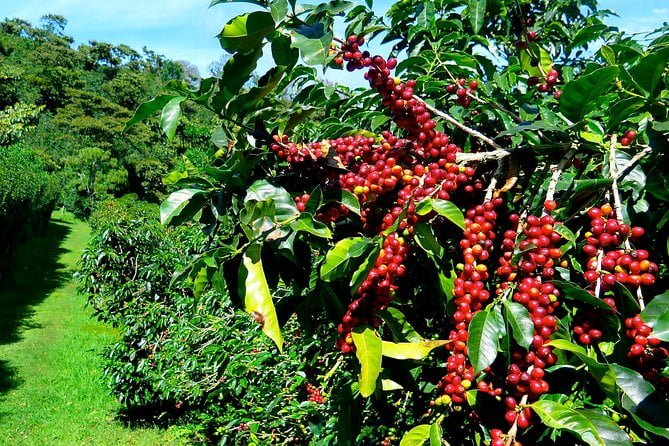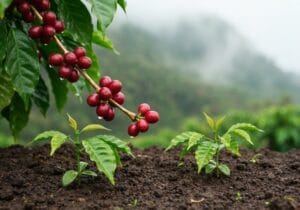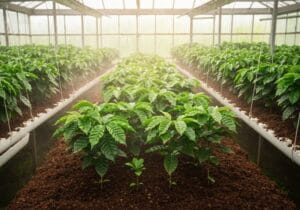To grow a healthy coffee plant, it’s all about the right climate, soil, and water management—think Goldilocks: not too hot, not too cold! Arabica coffee loves a cozy 18°C to 22°C, while Robusta is more of a sunbather. Rich, loamy soil is a must, and they drink up 1,500 to 2,500 mm of rain each year! And oh, don’t forget about good watering—deep roots are happy roots! Stick around to find out how to give your coffee plants a VIP treatment!
Key Takeaways
- Maintain ideal temperature ranges for Arabica (18°C to 22°C) and Robusta (22°C to 30°C) to promote healthy growth.
- Ensure rich, well-draining loamy soils with adequate nutrients like nitrogen, phosphorus, and potassium for optimal yield.
- Implement proper watering techniques, including deep watering and drip irrigation, to encourage strong root development and prevent waterlogging.
- Promote biodiversity and use agroforestry practices, such as mixed-species planting and shade trees, to enhance coffee plant resilience and health.
- Regularly test soil for nutrient balance and manage deficiencies to support overall plant vigor and productivity.
Climate and Environmental Conditions
In regards to nurturing a healthy coffee plant, the climate and environmental conditions are, let’s face it, kind of a big deal! Imagine trying to grow a coffee plant in the Arctic—oh boy, that would be a cringe-worthy scene!
The Arabica variety thrives at cozy temperatures, around 18°C to 22°C, while Robusta loves the warmer side, between 22°C and 30°C. Too cold? Growth slows; too hot? Pests throw a wild party! Ideal temperatures for Arabica range from 15°C to 24°C, making them sensitive to frost and extreme heat. Moreover, these conditions must be sustained without extremes harming plants to ensure healthy growth. Additionally, traditional Ethiopian agroforestry systems ensure biodiversity, which supports the overall health of coffee plants in their natural habitat.
Then there’s altitude—Arabica likes lofty heights, around 1,200 to 2,200 meters. Optimal Arabica growth at high altitudes correlates with increased sucrose and acidity, enhancing flavor complexity. Oh, and let’s not forget about rainfall! A solid 1,500 to 2,500 mm a year keeps these little guys happy.
Soil and Nutrient Factors
While it might not have crossed everyone’s mind, the soil and nutrient factors are like the backstage crew in a rock concert—doing all the heavy lifting while the coffee plants soak up the spotlight!
Picture a cold hardy coffee plant, jamming to rock anthems on rich, loamy soils; those deep roots need room to dance, right? Well-draining soil is like a VIP pass for the roots, preventing waterlogging and diseases.
And let’s not forget about nitrogen, phosphorus, and potassium, the rock stars of nutrients—the trio that keeps our coffee plants rocking and rolling!
Mulch like it’s confetti can work wonders for keeping that soil fertile, too.
Water Management

Even when some might think coffee is all about the beans (spoiler alert: it’s not just about the beans!), water management plays an essential role in keeping those coffee plants alive and thriving.
Did you know proper watering is vital for coffee plant facts? Yep! During dry spells, coffee plants crave deep watering to promote those stubborn roots. Forget those surface puddles; we want roots diving deep!
And if you think drip irrigation sounds fancy, you’re right – it can save tons of water while making plants happier than a barista with a double espresso!
Frequently Asked Questions
How Does Pruning Affect Coffee Plant Yield?
Pruning considerably improves coffee plant yield by promoting new branch and leaf growth. Data indicates that well-pruned plants can yield up to 49.7% more than unpruned varieties, optimizing total productivity and health in coffee cultivation.
What Role Do Beneficial Insects Play in Coffee Cultivation?
Beneficial insects play an essential role in coffee cultivation by enhancing pollination, controlling pests, improving soil health through nutrient cycling, and promoting biodiversity, ultimately leading to increased productivity and resilience in coffee agroecosystems.
How Can I Identify Nutrient Deficiencies in Coffee Plants?
To identify nutrient deficiencies in coffee plants, observe leaf color changes, distortion, and growth patterns. Yellowing, curling, or unusual shapes provide clues to specific deficiencies, guiding necessary soil amendments for ideal plant health.
What Are Common Pests That Affect Coffee Plants?
Common pests affecting coffee plants include Coffee Berry Borer, Coffee Leaf Miner, and Mealybugs, each causing significant damage to leaves and beans, thereby impacting total yield and quality. Integrated pest management helps control these threats effectively.
How Does Shade Impact Coffee Flavor Development?
Shade influences coffee flavor development by slowing cherry maturation, enhancing sugar accumulation and flavor complexity, while excessive shading may reduce quality in certain conditions. Ideal shade arrangements promote better biochemical composition and general flavor characteristics in coffee beans.
References
- https://pmc.ncbi.nlm.nih.gov/articles/PMC6025198/
- https://www.ctahr.hawaii.edu/oc/freepubs/pdf/b-113.pdf
- https://pmc.ncbi.nlm.nih.gov/articles/PMC10376224/
- https://www.britannica.com/topic/coffee-production
- http://www.coffeeresearch.org/agriculture/environment.htm
- https://icl-growingsolutions.com/agriculture/crops/coffee/





